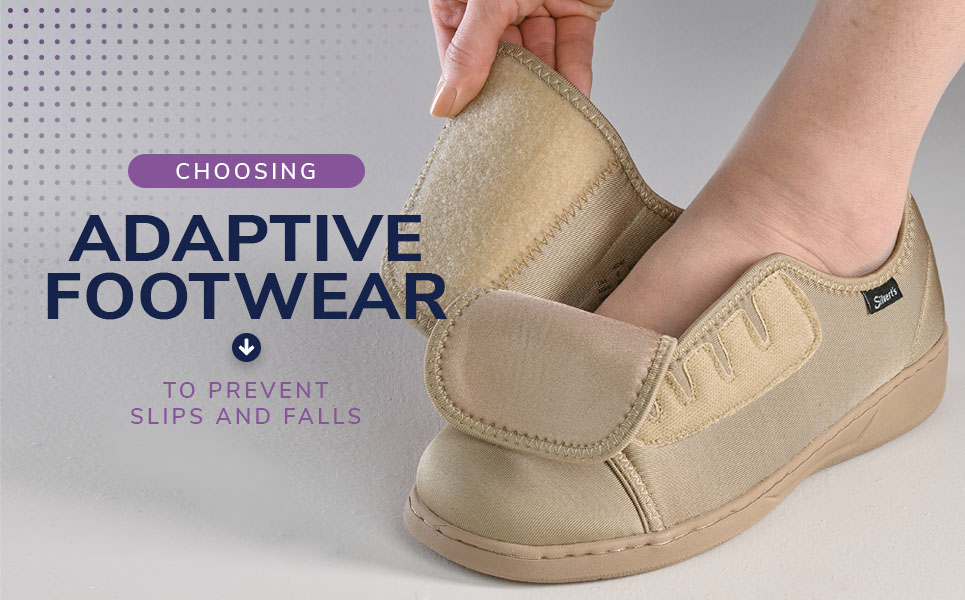Choosing Adaptive Footwear to Prevent Slips and Falls
Falls are one of the most common dangers to older adults, with about one in four older adults in the United States falling each year. Many of these falls are preventable, and wearing shoes at all times except sleeping is one of the best ways for seniors to significantly decrease their risks of tripping and falling. In this guide, we’ll explain what adaptive footwear is and how it can help prevent falls. Then we’ll dive into how to choose the best adaptive footwear for your needs and touch on some additional tips for fall prevention.
What Is Adaptive Footwear?
Adaptive footwear refers to shoes that are specifically designed to account for various health conditions, including mobility limitations and physical or developmental disabilities. Adaptive footwear is especially recommended for seniors for both safety and comfort reasons. Some benefits of adaptive footwear include:
- A thick, textured, rubber sole with a pronounced tread to help protect the bottom of the foot and to reduce the chances of slips and falls.
- A wide sole to accommodate lower body swelling, corns, bunions, hammertoes and other podiatry conditions that can’t fit into a regular width shoe.
- Large opening and adjustable tongues that will also accommodate swelling and other issues.
- A supportive insole that promotes proper alignment of the feet bones as well as good posture while walking.
- Comfortable yet durable materials (in particular the inner shoe lining) that do not aggravate sensory issues and are enjoyable to wear all day.
- Slip-on styles or easy fasteners made from Velcro that are easy to operate even with limited hand mobility.
If you have been struggling to find a regular shoe that is comfortable yet protective enough, we recommend switching your search to adaptive footwear instead. Many seniors who switch to adaptive shoes find them so pleasant that they never want to switch back!
How Adaptive Footwear Can Help Prevent Falls
Due to their unique features, adaptive footwear styles are among the best shoes that older adults can buy for fall prevention and general wear. First of all, adaptive shoes almost exclusively have non-skid soles, since they are designed for people who are often unsteady in their feet. This contrasts with regular shoes, as many have smooth soles that provide almost no grip at all. With adaptive footwear, you can rest assured that pretty much any pair you buy will feature a slip-resistant sole.
Adaptive footwear is also designed to provide a well-fitting shoe that can be adjusted over time. This is very important for older adults, as many experience lower body swelling that causes the size of their feet to fluctuate day to day. If shoes are too tight, they may not be able to wear them — but if shoes are too loose, they will create a tripping hazard. Adaptive shoes allow you to adjust them for the right fit using Velcro tabs and stretchy materials that conform to your feet. Check out our selection of the best shoes for swollen feet to see what we mean.

Those Velcro tabs combined with the large openings and wider soles make it a breeze to take them on and off your feet, whether you dress yourself or have someone to assist you. In many cases, putting on your adaptive footwear is as simple as putting your feet in the shoes and perhaps adjusting the Velcro tab. Now there can be no more excuses that wearing shoes in the house to prevent falls isn’t worth the hassle of taking them on and off.
Because of all the features we outlined in the above section, adaptive footwear is comfortable to wear all day, unlike stiff leather shoes that pinch and chafe your feet. This comfort will not only stop the shoes from exacerbating your existing foot problems but incentivize you to wear the footwear all day. In fact, many people find that their feet feel better after wearing their adaptive shoes all day (vs. their bare feet), which can’t be said for many regular shoes.
How to Choose the Right Adaptive Footwear
If you’re shopping for adaptive footwear, then you will almost certainly be shopping online from a specialty retailer such as Silverts, since very few stores carry adaptive footwear in person. This means that you will need to do your research ahead of time and properly measure your feet to maximize your chances of ordering the perfect pair of shoes for elderly women.
We also recommend buying from an online retailer with a generous returns policy so that it won’t be a hassle if you need a different size or style. For example, at Silverts we give you 60 days to return the merchandise in saleable condition if you’re not 100% satisfied with your purchase. When considering your options, you need to think about where you will be wearing your new adaptive footwear. Many people like to get a dedicated pair of women’s or men’s house slippers for wearing indoors and then wear other pairs outside in order to keep their floors clean. Depending on your needs, you might be shopping for one or both.
You also need to think about your specific needs and your preferred styles. For instance, an open toe house slipper might be fine for some seniors, but people with diabetic neuropathy in their feet will want a closed-toe shoe for 360 degree protection. You might also have a preference for slip-on vs. Velcro styles, or a specific color or fabric that you are looking for. Using these criteria can help you narrow down your search.

Once you know what style you want, you will also need to properly measure your foot and choose the correct size in your preferred design. To measure your foot, place a piece of paper underneath your bare foot and place all your weight on it. Then either draw an outline around your foot or ask someone to do it for you. Repeat the process on the other foot, and then measure the length of both outlines from the end of your big toe to your heel.
If your feet have two different measurements (which is true for most people), go with the foot that has the larger size. If your foot size tends to fluctuate a lot due to swelling or another factor, try to measure your foot when it seems to be at its largest to ensure that you get a big enough sole to accommodate your feet. Compare your measurements to the size chart for your chosen shoe and select the right size for your feet. If you are in between sizes, size up to leave room for any swelling.
Other Tips for Preventing Falls in Seniors
Wearing adaptive footwear isn’t the only thing that you can do to prevent falls; there are many practical steps that you can take in order to reduce your chances of tripping and falling. First, you should remove any potential hazards in your home, such as clutter on the floor, loose rugs and stray electrical cords. Make it a priority to keep your house clean and to prevent these obstacles from accumulating on the floor.
You should also install brighter light bulbs and/or extra lighting to ensure that you can clearly see the floor and the stairs (be cautious of electrical cords on lamps, however). Put motion-activated night lights in your bedroom, bathroom, hallways and any other areas that you frequent so that it won’t be dark if you get up in the middle of the night.
Installing grab bars in your bathroom and along the stairs will give you something to grab onto if your balance feels off. You might also want to get a shower chair if standing up in a shower is hard for you. Even if you don’t feel the need for a shower chair, you should still install non-slip bath mats in your tub or shower to keep your feet steady.

Don’t worry about taking extra time to navigate terrain; it’s better to go slow than to rush yourself and potentially fall. Take extra care when walking on icy or wet surfaces or traversing an area where leaves or other debris cover the ground. Sleep deprivation can also contribute to feelings of dizziness, so it’s important to ensure that you are getting enough rest. Regular exercise will help keep your body strong, and there are even exercises that you can do specifically to increase your sense of balance. A healthy diet is also important for keeping your body strong, as low blood sugar can make you feel weak and dizzy and contribute to a fall.
You should try to limit your consumption of alcohol, which impairs your judgment, balance and reaction time. If you’ve been drinking recently, don’t try to stand or walk until your body has had a chance to process it. Also be aware if any of your medications can heighten the effects of alcohol or are otherwise contraindicated by it. If you’re really unsteady on your feet, talk with your doctor to see if it’s time to get a cane and/or walker to help you out. You should also let your doctor know if you make any changes to your medication that cause an increase in dizziness, weakness, sleepiness or other issues with standing and walking.
Ready to buy some adaptive footwear for either yourself or a loved one? At SIlverts, we offer a broad range of adaptive shoe styles and sizes for people of all ages. Whether you are looking for some adaptive sandals for women or men’s house slippers, we’ve got you covered with our curated assortment. All U.S. orders ship free, and we also offer easy returns for 60 days so that you can buy your adaptive footwear from Silverts with confidence.
Image Credits
envastudio/Shutterstock.com
sasirin pamai/Shutterstock.com
MrTrush/Shutterstock.com





No Comments